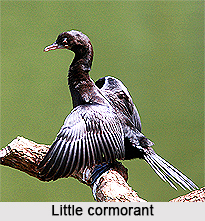 Little cormorant, an Indian Bird with a scientific name "Microcarbo niger" is a member of the cormorant family of seabirds. This bird is mainly found in Indian wetlands and water bodies.
Little cormorant, an Indian Bird with a scientific name "Microcarbo niger" is a member of the cormorant family of seabirds. This bird is mainly found in Indian wetlands and water bodies.
Concentration of Little Cormorant
Little cormorant is found across India, Sri Lanka, Bangladesh and lowland Nepal. It is also found in parts of Burma, Thailand, Laos and Indonesia. It is not found in the Himalayas, but vagrants have been seen in Ladakh. It inhabits wetlands, ranging from small village ponds to large lakes, and sometimes tidal estuaries.
Distribution of Little Cormorant
Little cormorant is widely distributed across the Indian Subcontinent and extends east to Java, where it is sometimes called the Javanese cormorant. It forages singly or sometimes in loose groups in lowland freshwater bodies, including small ponds, large lakes, streams and sometimes coastal estuaries. Like other cormorants, it is often found perched on a waterside rock with its wings spread out after coming out of the water. The entire body is black in the breeding season but the plumage is brownish, and the throat has a small whitish patch in the non-breeding season. These birds breed gregariously in trees, often joining other water birds at heronries.
Structure of Little Cormorant
Little Cormorant is slightly smaller than the Indian cormorant, it lacks a peaked head and has a shorter beak. Little cormorant is about 50 centimetres long and only slightly smaller than the Indian cormorant. The Indian cormorant has a narrower and longer bill which ends in a prominent hook tip, blue iris and a more pointed head profile. The breeding adult bird has a glistening all black plumage with some white spots and filoplumes on the face. There is also a short crest on the back of the head. The eyes, gular skin and face are dark. In the non-breeding bird or juvenile, the plumage is brownish and the bill and gular skin can appear more fleshy. The crest becomes inconspicuous and a small and well-marked white patch on the throat is sometimes visible. Towards the west of the Indus River valley, its range can overlap with vagrant pygmy cormorants, which can be difficult to differentiate in the field and are sometimes even considered con-specific. The sexes are indistinguishable in the field, but males tend to be larger.
Behaviour of Little Cormorant
Little Cormorants tend to forage mainly in small loose groups and are often seen foraging alone. They swim underwater to capture their prey, mainly fish. A study in northern India found that the little cormorant fished in water which was less than a metre deep and captured fishes of about 2-8 centimetres (0.79-3.15 in) length. They propel themselves underwater using their webbed feet. Captured fishes are often brought up to the surface to swallow them and during this time other birds including other little cormorants, painted storks, gulls and egrets may attempt to steal them. Indian cormorants tend to fish communally in larger groups.
Breeding of Little Cormorant
The breeding season of Little cormorant is between July to September in Pakistan and northern India and November to February in southern India. In Sri Lanka it is December to May. Males display at the nest site by fluttering their wings while holding their head back and bill raised. They then lower the bill, and after pairing the male also provides food to the female in courtship feeding. Both parents take part in building the nest, which is a platform of sticks placed on trees and sometimes even on coconut palms. They may nest beside Indian pond herons and little egrets in colonies. The nest is built in about two weeks. The whitish eggs turn muddy with age and incubation begins when the first egg is laid. This leads to asynchronous hatching and the chicks in a nest can vary considerably in age. The clutch size can vary from two to six eggs laid at intervals of about two days. The eggs hatch after 15 to 21 days. The downy chicks have a bare red head. The young birds are able to leave the nest after about a month.











